Kingdom of Kush
The Kingdom of Kush (/kʊʃ, kʌʃ/; Egyptian: 𓎡𓄿𓈙𓈉 kꜣš, Assyrian: ![]()
Kingdom of Kush | |||||||||||||||
|---|---|---|---|---|---|---|---|---|---|---|---|---|---|---|---|
| c. 1070 BC – c. 350 AD | |||||||||||||||
 The Kingdom of Kush circa 400 BC | |||||||||||||||
| Capital | Napata, Meroë | ||||||||||||||
| Common languages | Meroitic language, Nubian languages, Egyptian,[2] Cushitic[3] | ||||||||||||||
| Religion | Ancient Egyptian Religion | ||||||||||||||
| Government | Monarchy | ||||||||||||||
| Monarch | |||||||||||||||
| Historical era | Iron Age to Late Antiquity | ||||||||||||||
• Established | c. 1070 BC | ||||||||||||||
• Capital moved to Meroe | 591 BC | ||||||||||||||
• Disestablished | c. 350 AD | ||||||||||||||
| Population | |||||||||||||||
• Meroite phase[4] | 1,150,000 | ||||||||||||||
| |||||||||||||||
| Today part of | |||||||||||||||
The Kushite era of rule in Nubia was established after the Late Bronze Age collapse and the disintegration of the New Kingdom of Egypt. Kush was centered at Napata (now modern Karima, Sudan) during its early phase. After Kashta ("the Kushite") invaded Egypt in the 8th century BC, the monarchs of Kush were also the pharaohs of the Twenty-fifth Dynasty of Egypt, until they were defeated by the Neo-Assyrian Empire in the Assyrian conquest of Egypt under the rule of Ashurbanipal a century later, and finally expelled from Egypt itself by Psamtik I.
During classical antiquity, the Kushite imperial capital was located at Meroë. In early Greek geography, the Meroitic kingdom was known as Aethiopia. The Kingdom of Kush with its capital at Meroe persisted until the 4th century AD, when it weakened and disintegrated due to internal rebellion. The seat was eventually captured and burnt to the ground by the Kingdom of Aksum. Afterwards the Nubians established the three, eventually Christianized, kingdoms of Nobatia, Makuria and Alodia.
Name
| Kush in hieroglyphs | |||||
|---|---|---|---|---|---|
k3š Ku'sh | |||||
The native name of the Kingdom was recorded in Egyptian as k3š, likely pronounced [kuɫuʃ] or [kuʔuʃ] in Middle Egyptian, when the term was first used for Nubia, based on the New Kingdom-era Akkadian transliteration as the genitive kūsi.[5][6][7]
It is also an ethnic term for the native population who initiated the kingdom of Kush. The term is also displayed in the names of Kushite persons,[8] such as King Kashta (a transcription of k3š-t3 "(one from) the land of Kush"). Geographically, Kush referred to the region south of the first cataract in general. Kush also was the home of the rulers of the 25th Dynasty.[9]
The name Kush, since at least the time of Josephus, has been connected with the biblical character Cush, in the Hebrew Bible (Hebrew: כּוּשׁ), son of Ham (Genesis 10:6). Ham had four sons named: Cush, Put, Canaan and Mizraim (Hebrew name for Egypt). According to the Bible, Nimrod, a son of Cush, was the founder and king of Babylon, Erech, Akkad and Calneh, in Shinar (Gen 10:10).[10] The Bible also makes reference to someone named Cush who is a Benjamite (Psalms 7:1, KJV).[11]
In Greek sources Kush was known as Kous (Κους) or Aithiopia (Αἰθιοπία).[12]
History
Origins
Mentuhotep II, the 21st century BC founder of the Middle Kingdom, is recorded to have undertaken campaigns against Kush in the 29th and 31st years of his reign. This is the earliest Egyptian reference to Kush; the Nubian region had gone by other names in the Old Kingdom.[13] Under Thutmose I, Egypt made several campaigns south.[14] This eventually resulted in their annexation of Nubia c. 1504 BC. After the conquest, Kerma culture was increasingly Egyptianized, yet rebellions continued for 220 years until c. 1300 BC. Nubia nevertheless became a key province of the New Kingdom, economically, politically and spiritually. Indeed, major pharonic ceremonies were held at Jebel Barkal near Napata.[15] As an Egyptian colony from the 16th century BC, Nubia ("Kush") was governed by an Egyptian Viceroy of Kush. With the disintegration of the New Kingdom around 1070 BC, Kush became an independent kingdom centered at Napata in modern northern Sudan.[16]
The extent of cultural/political continuity between the Kerma culture and the chronologically succeeding Kingdom of Kush is difficult to determine. The latter polity began to emerge around 1000 BC, 500 years after the end of the Kingdom of Kerma. By 1200 BC, Egyptian involvement in the Dongola Reach was nonexistent. By the 8th century BC, the new Kushite kingdom emerged from the Napata region of the upper Dongola Reach. The first Napatan king, Alara, dedicated his sister to the cult of Amun at the rebuilt Kawa temple, while temples were also rebuilt at Barkal and Kerma. A Kashta stele at Elephantine, places the Kushites on the Egyptian frontier by the mid-eighteenth century. This first period of the kingdom's history, the 'Napatan', was succeeded by the 'Meroitic', when the royal cemeteries relocated to Meroë around 300 BC.[17]
The Kushites buried their monarchs along with all their courtiers in mass graves. Archaeologists refer to these practices as the "Pan-grave culture".[18] This was given its name due to the way in which the remains are buried. They would dig a pit and put stones around them in a circle.[19] Kushites also built burial mounds and pyramids, and shared some of the same gods worshiped in Egypt, especially Ammon and Isis. With the worshiping of these gods, the Kushites began to take some of the names of the gods as their throne names.[9]
The Kush rulers were regarded as guardians of the state religion and were responsible for maintaining the houses of the gods. Some scholars believe the economy in the Kingdom of Kush was a redistributive system. The state would collect taxes in the form of surplus produce and would redistribute to the people. Others believe that most of the society worked on the land and required nothing from the state and did not contribute to the state. Northern Kush seems to have been more productive and wealthier than the Southern area.[20]
Dental trait analysis of fossils dating from the Meroitic period in Semna, northern Nubia, found that they displayed traits similar to those of populations inhabiting the Nile, Horn of Africa, and Maghreb. The Meroitic skeletons and these ancient and recent fossils were also phenotypically distinct from those belonging to recent Niger–Congo and Khoisan-speaking populations in Sub-Saharan Africa, as well as from the Mesolithic inhabitants of Jebel Sahaba in Nubia.[21]
Conquest of Egypt (25th Dynasty)

Resistance to the early eighteenth Dynasty Egyptian rule by neighbouring Kush is evidenced in the writings of Ahmose, son of Ebana, an Egyptian warrior who served under Nebpehtrya Ahmose (1539-1514 BC), Djeserkara Amenhotep I (1514–1493 BC) and Aakheperkara Thutmose I (1493–1481 BC). At the end of the Second Intermediate Period (mid-sixteenth century BC), Egypt faced the twin existential threats—the Hyksos in the North and the Kushites in the South. Taken from the autobiographical inscriptions on the walls of his tomb-chapel, the Egyptians undertook campaigns to defeat Kush and conquer Nubia under the rule of Amenhotep I (1514–1493 BC). In Ahmose's writings, the Kushites are described as archers, "Now after his Majesty had slain the Bedoin of Asia, he sailed upstream to Upper Nubia to destroy the Nubian bowmen."[22] The tomb writings contain two other references to the Nubian bowmen of Kush.
Egypt's international prestige had declined considerably towards the end of the Third Intermediate Period. Its historical allies, the inhabitants of Canaan, had fallen to the Middle Assyrian Empire (1365-1020 BC), and then the resurgent Neo-Assyrian Empire (935–605 BC). The Assyrians, from the 10th century BC onwards, had once more expanded from northern Mesopotamia, and conquered a vast empire, including the whole of the Near East, and much of Anatolia, the eastern Mediterranean, the Caucasus and early Iron Age Iran.
In 945 BC, Shoshenq I and Libu princes took control of the Nile Delta and founded the Twenty-second Dynasty of Egypt, also known as the Libyan or Bubastite dynasty, which would rule for some 200 years. Shoshenq also gained control of southern Egypt by placing his family members in important priestly positions. In 711, Shoshenq made Memphis his northern capital.[23] However, Libyan control began to erode as a rival dynasty in the delta arose in Leontopolis and Kushites threatened from the south.
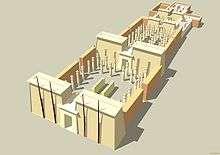
Alara founded the Napatan, or 25th, Kushite dynasty at Napata in Nubia, now Sudan. Alara's successor Kashta extended Kushite control north to Elephantine and Thebes in Upper Egypt. Kashta's successor Piye seized control of Lower Egypt around 727 BC.[24] Piye's 'Victory Stela', celebrating these campaigns between 728-716 BC, was found in the Amun temple at Jebel Barkal. He invaded an Egypt fragmented into four kingdoms, ruled by King Peftjauawybast, King Nimlot, King Iuput II, and King Osorkon IV.[25]:115,120
Why the Kushites chose to enter Egypt at this crucial point of foreign domination is subject to debate. Archaeologist Timothy Kendall offers his own hypotheses, connecting it to a claim of legitimacy associated with Jebel Barkal.[26] Kendall cites the Victory Stele of Piye at Jebel Barkal, which states that "Amun of Napata granted me to be ruler of every foreign country," and "Amun in Thebes granted me to be ruler of the Black Land (Kmt)". According to Kendall, "foreign lands" in this regard seems to include Lower Egypt while "Kmt" seems to refer to a united Upper Egypt and Nubia.[26]
Piye's successor, Shabaqo, defeated the Saite kings of northern Egypt between 711-710 BC, and installed himself as king in Memphis. He then established ties with Sargon II.[25]:120
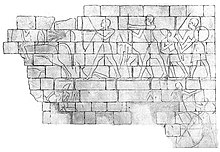
Piye's son Taharqa enjoyed some minor initial success in his attempts to regain Egyptian influence in the Near East. He aided King Hezekiah from attack by Sennacherib and the Assyrians (2 Kings 19:9; Isaiah 37:9), however disease among the besieging Assyrian army appears to have been the main cause of failure to take Jerusalem rather than any military setback, and Assyrian records indicate Hezekiah was forced to pay tribute. The Assyrian King Sennacherib then defeated Taharqa and drove the Nubians and Egyptians from the region and back over the Sinai into Egypt.
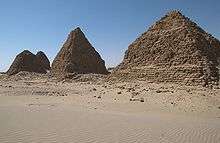
The power of the 25th Dynasty reached a climax under Taharqa. The Nile valley empire was as large as it had been since the New Kingdom. New prosperity[27] revived Egyptian culture.[28] Religion, the arts, and architecture were restored to their glorious Old, Middle, and New Kingdom forms. The Nubian pharaohs built or restored temples and monuments throughout the Nile valley, including Memphis, Karnak, Kawa, and Jebel Barkal.[29] It was during the 25th dynasty that the Nile valley saw the first widespread construction of pyramids (many in modern Sudan) since the Middle Kingdom.[30][31][32] The Kushites developed their own script, the Meroitic alphabet, which was influenced by Egyptian writing systems c. 700–600 BC, although it appears to have been wholly confined to the royal court and major temples.[33]
Taharqa initially defeated the Assyrians when war broke out in 674 BC. Yet, in 671 BC, the Assyrian King Esarhaddon started the Assyrian conquest of Egypt, took Memphis, and Taharqo retreated to the south, while his heir and other family members were taken to Assyria as prisoners. However, the native Egyptian vassal rulers installed by Esarhaddon as puppets were unable to effectively retain full control, and Taharqa was able regain control of Memphis. Esarhaddon's 669 BC campaign to once more eject Taharqa was abandoned when Esarhaddon died in Palestine on the way to Egypt. Yet, Esarhaddon's successor, Ashurbanipal, did defeat Taharqa, and Taharqa died soon after.[25]:121

Taharqa's successor Tantamani attempted to regain Egypt. He successfully defeated Necho, the subject ruler installed by Ashurbanipal, taking Memphis in the process. The Assyrians, who had a military presence in the Levant, then sent a large army southwards in 663 BC. Tantamani was routed, and the Assyrian army sacked Thebes to such an extent it never truly recovered. Tantamani was chased back to Nubia, but his control over Upper Egypt endured until c. 656 BC. At this date, a native Egyptian ruler, Psamtik I son of Necho, placed on the throne as a vassal of Ashurbanipal, took control of Thebes.[27][35] The last links between Kush and Upper Egypt were severed after hostilities with the Saite kings in the 590s BC.[25]:121–122
Napatan period
Aspelta moved the capital to Meroë, considerably farther south than Napata, possibly c. 591 BC,[36] just after the sack of Napata by Psamtik II.
Martin Meredith states the Kushite rulers chose Meroë, between the Fifth and Sixth Cataracts, because it was on the fringe of the summer rainfall belt, and the area was rich in iron ore and hardwood for iron working. The location also afforded access to trade routes to the Red Sea. The Kush traded iron products with the Romans, in addition to gold, ivory and slaves. Yet, the Butana plain was stripped of its forests, leaving behind slag piles.[37][38]
The Kushites used the animal-driven water wheel to increase productivity and create a surplus, particularly during the Napatan-Meroitic Kingdom.[39]
Achaemenid control
Herodotus mentioned an invasion of Kush by the Achaemenid ruler Cambyses (c. 530 BC), who possibly succeeded in occupying the area between the first and second Nile cataract.[40] Achaemenid inscriptions from both Egypt and Iran include Kush as part of the Achaemenid empire.[41] For example, the DNa inscription of Darius I (r. 522–486 BC) on his tomb at Naqsh-e Rustam mentions Kūšīyā (Old Persian cuneiform: 𐎤𐎢𐏁𐎡𐎹𐎠, pronounced Kūshīyā) among the territories being "ruled over" by the Achaemenid Empire.[42][41] Archaeological evidence suggests that the fortress of Dorginarti near the second cataract served as Persia's southern boundary.[43]
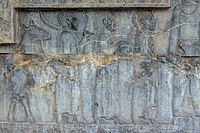 Kushite delegation on a Persian relief from the Apadana palace (c. 500 BC)
Kushite delegation on a Persian relief from the Apadana palace (c. 500 BC).jpg) Kushite subject on the Statue of Darius the Great (c. 550–486 BCE)
Kushite subject on the Statue of Darius the Great (c. 550–486 BCE)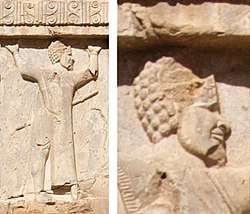 Kushite soldier of the Achaemenid army, on the tomb of Xerxes I
Kushite soldier of the Achaemenid army, on the tomb of Xerxes I
Meroitic period
In about 300 BC the move to Meroë was made more complete when the monarchs began to be buried there, instead of at Napata. One theory is that this represents the monarchs breaking away from the power of the priests at Napata. According to Diodorus Siculus, a Kushite king, "Ergamenes", defied the priests and had them slaughtered. This story may refer to the first ruler to be buried at Meroë with a similar name such as Arqamani,[45] who ruled many years after the royal cemetery was opened at Meroë. During this same period, Kushite authority may have extended some 1,500 km along the Nile River valley from the Egyptian frontier in the north to areas far south of modern Khartoum and probably also substantial territories to the east and west.[46]
Kushite civilization continued for several centuries. In the Napatan Period Egyptian hieroglyphs were used: at this time writing seems to have been restricted to the court and temples. From the 2nd century BC there was a separate Meroitic writing system. This was an alphabetic script with 23 signs used in a hieroglyphic form (mainly on monumental art) and in a cursive form. The latter was widely used; so far some 1278 texts using this version are known (Leclant 2000). The script was deciphered by Griffith, but the language behind it is still a problem, with only a few words understood by modern scholars. It is not as yet possible to connect the Meroitic language with other known languages.[33]
Strabo describes a war with the Romans in the 1st century BC. After the initial victories of Kandake (or "Candace") Amanirenas against Roman Egypt, the Kushites were defeated and Napata sacked.[47] Remarkably, the destruction of the capital of Napata was not a crippling blow to the Kushites and did not frighten Candace enough to prevent her from again engaging in combat with the Roman military. Indeed, it seems that Petronius's attack might have had a revitalizing influence on the kingdom. Just three years later, in 22 BC, a large Kushite force moved northward with intention of attacking Qasr Ibrim.[48]:149
.jpg)
Alerted to the advance, Petronius again marched south and managed to reach Qasr Ibrim and bolster its defences before the invading Kushites arrived. Although the ancient sources give no description of the ensuing battle, we know that at some point the Kushites sent ambassadors to negotiate a peace settlement with Petronius. By the end of the second campaign, however, Petronius was in no mood to deal further with the Kushites.[48]:149 The Kushites succeeded in negotiating a peace treaty on favourable terms[47] and trade between the two nations increased.[48]:149 Some historians like Theodore Mommsen wrote that during Augustus times Nubia was a possible client state of the Roman Empire.
It is possible that the Roman emperor Nero planned another attempt to conquer Kush before his death in AD 68.[48]:150–151 Nero sent two centurions upriver as far as Bahr el Ghazal River in 66 AD in an attempt to discover the source of the Nile.[37]:43 Kush began to fade as a power by the 1st or 2nd century AD, sapped by the war with the Roman province of Egypt and the decline of its traditional industries.[49] Christianity began to gain over the old pharaonic religion and by the mid-sixth century AD the Kingdom of Kush was dissolved.[20]
Language
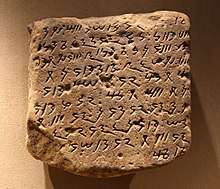
The Meroitic language was spoken in Meroë and the Sudan during the Meroitic period (attested from 300 BC). It became extinct about 400 AD. The language was written in two forms of the Meroitic alphabet: Meroitic Cursive, which was written with a stylus and was used for general record-keeping; and Meroitic Hieroglyphic, which was carved in stone or used for royal or religious documents. It is not well understood due to the scarcity of bilingual texts. The earliest inscription in Meroitic writing dates from between 180–170 BC. These hieroglyphics were found engraved on the temple of Queen Shanakdakhete. Meroitic Cursive is written horizontally, and reads from right to left like all Semitic orthographies.[50]
By the 3rd century BC, a new indigenous alphabet, the Meroitic, consisting of twenty-three letters, replaced Egyptian script. Meroitic is an alphabet originally derived from Egyptian hieroglyphs that was used to write the Meroitic language of the Kingdom of Meroë/Kush. It was developed in the Napatan Period (about 700–300 BC), and first appears in the second century BC. For a time, it was also possibly used to write the Old Nubian language of the successor Nubian kingdoms.[51]
It is uncertain to which language family the Meroitic language is related. Kirsty Rowan suggests that Meroitic, like the Egyptian language, belongs to the Afro-Asiatic family. She bases this on its sound inventory and phonotactics, which she argues are similar to those of the Afro-Asiatic languages and dissimilar from those of the Nilo-Saharan languages.[52][53] Claude Rilly proposes that Meroitic, like the Nobiin language, belongs to the Eastern Sudanic branch of the Nilo-Saharan family, based in part on its syntax, morphology, and known vocabulary.[54][55][56]
Kush and Egyptology
On account of the Kingdom of Kush's proximity to Ancient Egypt — the first cataract at Elephantine usually being considered the traditional border between the two polities — and because the 25th dynasty ruled over both states in the 8th century BC, from the Rift Valley to the Taurus mountains, historians have closely associated the study of Kush with Egyptology, in keeping with the general assumption that the complex sociopolitical development of Egypt's neighbours can be understood in terms of Egyptian models.[57] As a result, the political structure and organization of Kush as an independent ancient state has not received as thorough attention from scholars, and there remains much ambiguity especially surrounding the earliest periods of the state. Edwards[57] has suggested that study of the region could benefit from increased recognition of Kush as a state in its own right, with distinct cultural conditions, rather than merely as a secondary state on the periphery of Egypt.
References
- László Török, The Kingdom of Kush: Handbook of the Napatan-Meroitic Civilization (Leiden: Brill, 1997), p. 2.
- Török, László (January 1997). The Kingdom of Kush: History and Civilization. Brill. p. 49. ISBN 978-9004104488. Retrieved 21 February 2017.
- Rilly, Claude (2019). "Languages of Ancient Nubia". Handbook of Ancient Nubia. pp. 133–134. Retrieved 2019-11-20.
The Blemmyan language is so close to modern Beja that it is probably nothing else than an early dialect of the same language.
- Goldenberg, David M. (2005). The Curse of Ham: Race and Slavery in Early Judaism, Christianity, and Islam (New ed.). Princeton University Press. p. 17. ISBN 978-0691123707.
- Spalinger, Anthony (1974). "Esarhaddon and Egypt: An Analysis of the First Invasion of Egypt". Orientalia, NOVA SERIES, Vol. 43 Pp. 295-326, XI.
- Allen, James P. (2013-07-11). The Ancient Egyptian Language: An Historical Study. Cambridge University Press. p. 53. ISBN 9781107032460. Retrieved 2015-04-15.
- Török, László. Der Nahe und Mittlere Osten. BRILL, 1997. Print.
- Van, de M. M. A History of Ancient Egypt. Chichester, West Sussex: Wiley-Blackwell, 2011. Print.
- "GENESIS 10:10 KJV "And the beginning of his kingdom was Babel, and Erech, and Accad, and Calneh, in the land of Shinar."". www.kingjamesbibleonline.org.
- "PSALMS CHAPTER 7 KJV". www.kingjamesbibleonline.org.
- Török (1997), p. 69ff.
- Historical Dictionary of Ancient and Medieval Nubia, Richard A. Lobban Jr., p. 254.
- De Mola, Paul J. "Interrelations of Kerma and Pharaonic Egypt". Ancient History Encyclopedia: http://www.ancient.eu/article/487/
- "Jebal Barkal: History and Archaeology of Ancient Napata". Archived from the original on 19 September 2012. Retrieved 21 March 2012.
- Morkot, Robert G. "On the Priestly Origin of the Napatan Kings: The Adaptation, Demise and Resurrection of Ideas in Writing Nubian History" in O'Connor, David and Andrew Reid, eds. Ancient Egypt in Africa (Encounters with Ancient Egypt) (University College London Institute of Archaeology Publications) Left Coast Press (1 Aug 2003) ISBN 978-1-59874-205-3 p.151
- Edwards, David (2004). The Nubian Past. Oxon: Routledge. pp. 2, 75, 112, 114–117, 120. ISBN 9780415369886.
- Pan Grave Culture – By K. Kris Hirst
- Archived 2013-10-24 at the Wayback Machine – By Manfred Bietak
- Welsby, Derek A. The Kingdom of Kush: the Napatan and Meroitic Empires. Princeton, NJ: Markus Wiener, 1998. Google Scholar. Web. 20 Oct. 2011
- Irish, Joel D. (1998). "Dental morphological affinities of Late Pleistocene through recent sub-Saharan and north African peoples" (PDF). Bulletins et Mémoires de la Société d'anthropologie de Paris. 10 (3): 237–272. doi:10.3406/bmsap.1998.2517. Retrieved 17 June 2017.
- Wilkinson, Toby (2016). Writings from Ancient Egypt. United Kingdom: Penguin Classics. p. 19. ISBN 978-0-141-39595-1.
- Van, de M. M. A History of Ancient Egypt. Chichester, West Sul"ssex: Wiley-Blackwell, 2011. p289. Print.
- Shaw (2002) p. 345
- Edwards, David (2004). The Nubian Past. Oxon: Routledge. pp. 2, 75, 77–78. ISBN 9780415369886.
- Kendall, T.K., 2002. Napatan Temples: a Case Study from Gebel Barkal. The Mythological Nubian Origin of Egyptian Kingship and the Formation of the Napatan State. Tenth International Conference of Nubian Studies. Rome, September 9–14, 2002.
- Török, László. The Kingdom of Kush: Handbook of the Napatan-Meroitic Civilization. Leiden: Brill, 1997. Google Scholar. Web. 20 Oct. 2011.
- Diop, Cheikh Anta (1974). The African Origin of Civilization. Chicago, Illinois: Lawrence Hill Books. pp. 219–221. ISBN 1-55652-072-7.
- Bonnet, Charles (2006). The Nubian Pharaohs. New York: The American University in Cairo Press. pp. 142–154. ISBN 978-977-416-010-3.
- Mokhtar, G. (1990). General History of Africa. California, USA: University of California Press. pp. 161–163. ISBN 0-520-06697-9.
- Emberling, Geoff (2011). Nubia: Ancient Kingdoms of Africa. New York: Institute for the Study of the Ancient World. pp. 9–11.
- Silverman, David (1997). Ancient Egypt. New York: Oxford University Press. pp. 36–37. ISBN 0-19-521270-3.
- "Meroitic script". www.digitalegypt.ucl.ac.uk.
- Elshazly, Hesham. "Kerma and the royal cache". Cite journal requires
|journal=(help) - Georges Roux – Ancient Iraq pp. 330–332
- Festus Ugboaja Ohaegbulam (1 October 1990). Towards an understanding of the African experience from historical and contemporary perspectives. University Press of America. p. 66. ISBN 978-0-8191-7941-8. Retrieved 17 March 2011.
- Meredith, Martin (2014). The Fortunes of Africa. New York: Public Affairs. pp. 43–44. ISBN 9781610396356.
- Shillington, Kevin (2012). History of Africa. London: Palgrave Macmillan. pp. 50–51. ISBN 9780230308473.
- William Y. Adams, Nubia: Corridor to Africa (Princeton University Press, 1977) 346-47, and William Y. Adams,
- Dandamaev, M. A. (1989). A Political History of the Achaemenid Empire. BRILL. pp. 80–81. ISBN 9004091726.
- Sircar, Dineschandra (1971). Studies in the Geography of Ancient and Medieval India. Motilal Banarsidass. p. 25. ISBN 9788120806900.
- Line 30 of the DNa inscription
- Welsby, Derek (1998). The Kingdom of Kush. Markus Wiener Publishers. p. 66.
- Centre, UNESCO World Heritage. "Gebel Barkal and the Sites of the Napatan Region". whc.unesco.org.
- Fage, J. D.: Roland Anthony Oliver (1979) The Cambridge History of Africa, Cambridge University Press. ISBN 0-521-21592-7 p. 228
- Edwards, page 141
- Arthur E. Robinson, "The Arab Dynasty of Dar For (Darfur): Part II", Journal of the Royal African Society (Lond). XXVIII: 55–67 (October, 1928)
- Jackson, Robert B. (2002). At Empire's Edge: Exploring Rome's Egyptian Frontier. Yale University Press. ISBN 0300088566.
- "BBC World Service - The Story of Africa". www.bbc.co.uk.
- Fischer, Steven Roger (2004). History of Writing. Reaktion Books. pp. 133–134. ISBN 1861895887. Retrieved 16 January 2015.
- ""Meroe: Writing", Digital Egypt, University College, London". Digitalegypt.ucl.ac.uk. Retrieved 2012-09-06.
- Rowan, Kirsty (2011). "Meroitic Consonant and Vowel Patterning". Lingua Aegytia, 19.
- Rowan, Kirsty (2006), "Meroitic - An Afroasiatic Language?" SOAS Working Papers in Linguistics 14:169–206.
- Rilly, Claude & de Voogt, Alex (2012). The Meroitic Language and Writing System. Cambridge, UK: Cambridge University Press. ISBN 978-1107008663.CS1 maint: uses authors parameter (link)
- Rilly, Claude (2004). "The Linguistic Position of Meroitic" (PDF). Sudan Electronic Journal of Archaeology and Anthropology. Archived from the original (PDF) on 2015-09-23. Retrieved 2017-11-02.
- Rilly C (June 2016). "Meroitic". UCLA Encyclopedia of Egyptology.
- "David N. Edwards, "Meroe and the Sudanic Kingdoms", "Journal of African History" (UK). Vol. 39 No. 2 (1998), pp 175–193".
Bibliography
- Edwards, David N. (2004). The Nubian Past. London: Routledge. pp. 348 Pages. ISBN 0-415-36987-8.
- Fisher, Marjorie M.; Lacovara, Peter; Ikram, Salima; et al., eds. (2012). Ancient Nubia: African Kingdoms on the Nile. The American University in Cairo Press. ISBN 978-977-416-478-1.
- Leclant, Jean (2004). The empire of Kush: Napata and Meroe. London: UNESCO. pp. 1912 Pages. ISBN 1-57958-245-1.
- Oliver, Roland (1978). The Cambridge history of Africa. Vol. 2, From c. 500 BC to AD 1050. Cambridge: Cambridge University Press. pp. 858 Pages. ISBN 0-521-20981-1.
- Oliver, Roland (1975). The Cambridge History of Africa Volume 3 1050 – c. 1600. Cambridge: Cambridge University Press. pp. 816 Pages. ISBN 0-521-20981-1.
- Shillington, Kevin (2004). Encyclopedia of African History, Vol. 1. London: Routledge. pp. 1912 Pages. ISBN 1-57958-245-1.
- Török, László (1998). The Kingdom of Kush: Handbook of the Napatan-Meriotic Civilization. Leiden: BRILL. pp. 589 Pages. ISBN 90-04-10448-8.
Further reading
- Baud, Michel (2010). Méroé. Un empire sur le Nil (in French). Officina Libraria. ISBN 978-8889854501.CS1 maint: ref=harv (link)
- Breyer, Francis (2014). Einführung in die Meroitistik (in German). Lit. ISBN 9783643128058.CS1 maint: ref=harv (link)
- Valbelle, Dominique; Bonnet, Charles (2006). The Nubian Pharaohs. The American University in Cairo Press. ISBN 978-9774160103.
- Yvanes, Elsa (2018). "Clothing the elite? Patterns of textile production and consumption in ancient Sudan and Nubia". Dynamics and Organisation of Textile Production in Past Societies in Europe and the Mediterranean. pp. 81–92.CS1 maint: ref=harv (link)
External links
| Wikimedia Commons has media related to Kingdom of Kush. |
- Dan Morrison, "Ancient Gold Center Discovered on the Nile", National Geographic News
- "Civilizations in Africa: Kush", Washington State University
- African Kingdoms | Kush
- Ancient Sudan (Nubia) website
- John Noble Wilford, "Scholars Race to Recover a Lost Kingdom on the Nile", New York Times (June 19, 2007).
- Joseph Poplicha, "The Biblical Nimrod and the Kingdom of Eanna", Journal of the American Oriental Society, Vol. 49, (1929), pp. 303–317
- Kerma website Official website of the Swiss archeological mission to Sudan.

